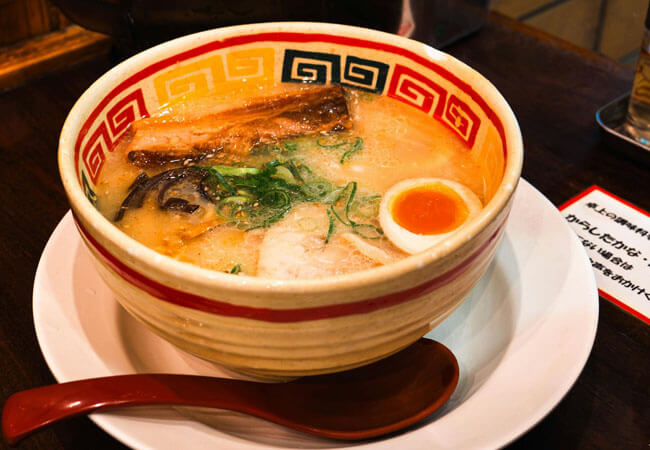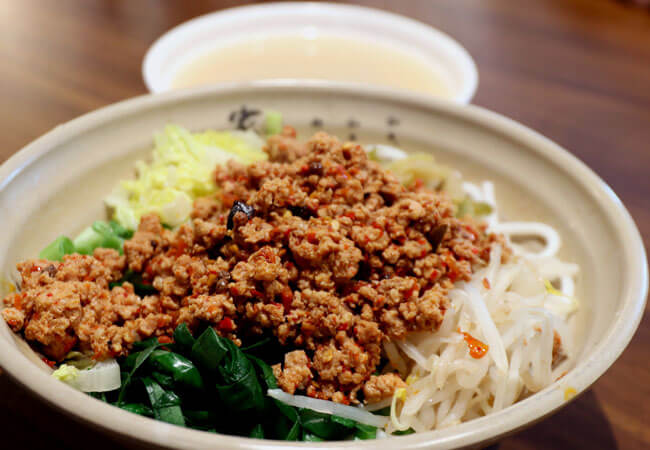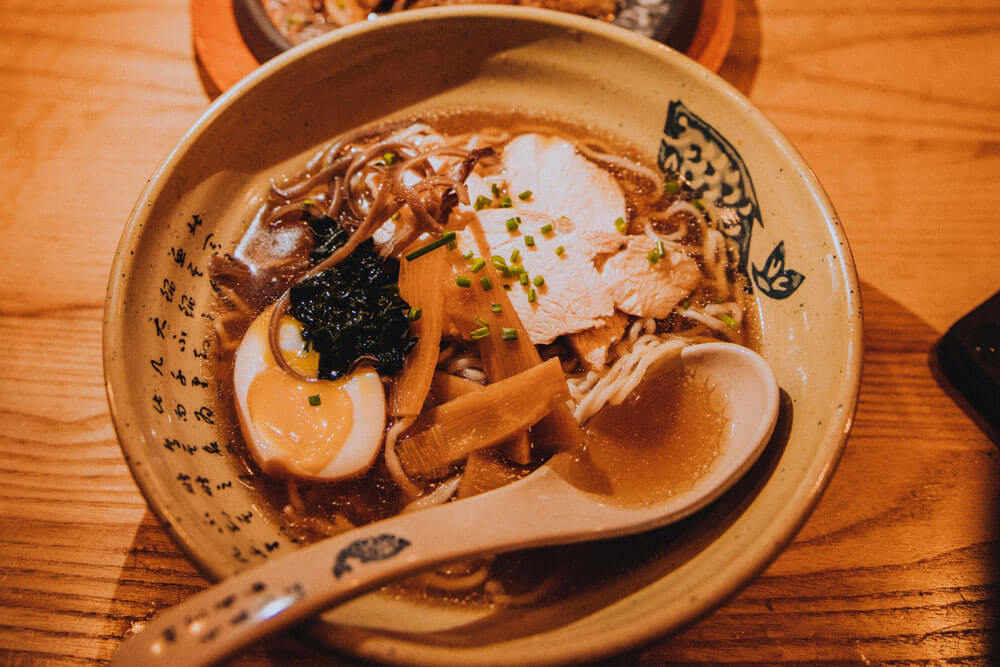Rannicchiato sul tuo comodo divano, sorseggiando una fumante ciotola di gustosi noodles, potresti ritrovarti a riflettere su un enigma culinario: il ramen è cinese o giapponese? È una domanda che solletica le papille gustative e accende la curiosità degli amanti del cibo in tutto il mondo.
In questo articolo del blog, ci imbarcheremo in un viaggio saporito attraverso la storia intricata di questo amato piatto, scoprendo i sorprendenti colpi di scena che ne hanno plasmato l'identità. Quindi, afferrate le bacchette e preparatevi ad assaporare ogni boccone di conoscenza mentre sveliamo il mistero delle origini del ramen.
Sì, la maggior parte del Ramen che vedi è cibo giapponese
Quando passeggi per le strade trafficate della città fiancheggiate da negozi di ramen illuminati al neon, è difficile negare che la maggior parte del ramen che incontri è inconfondibilmente giapponese. Dai vicoli trafficati di Tokyo ai quartieri alla moda di New York City, sono le iconiche ciotole di ramen giapponesi a rubare la scena. Queste ciotole sono spesso caratterizzate dai loro ricchi brodi ricchi di umami, dai noodles gommosi e da una serie di condimenti come tenere fette di maiale chashu, germogli di bambù marinati e uova alla coque perfette.
Con ogni sorso, vieni trasportato nel cuore del Giappone, dove la cultura del ramen prospera e l'innovazione non conosce limiti. Sebbene il piatto possa avere le sue radici in Cina, sono i giapponesi ad averlo perfezionato e reso popolare, rendendo il ramen parte integrante della loro identità culinaria e un fenomeno gastronomico globale. Quindi, la prossima volta che hai voglia di una confortante ciotola di noodles, è probabile che ti ritroverai a concederti gli squisiti sapori del ramen giapponese.
Ma il ramen è originario della Cina
Sebbene le strade trafficate di Tokyo possano essere sinonimo di noodles da sorseggiare, è essenziale riconoscere che le origini del ramen possono essere fatte risalire alla Cina. Secoli fa, gli immigrati cinesi portarono la loro competenza nella preparazione dei noodles in Giappone, gettando le basi per quello che alla fine si sarebbe evoluto nell'amato piatto che conosciamo come ramen.
Si ritiene infatti che la parola giapponese per ramen, "ラーメン" (rāmen), abbia avuto origine dal termine cinese "拉麵" (lāmiàn), che significa "spaghetti tirati". Ciò riflette il legame storico tra le tradizioni culinarie cinese e giapponese, con il concetto di spaghetti introdotto in Giappone dalla Cina, dove venivano tradizionalmente realizzati stirando a mano l'impasto in fili lunghi e sottili.
I documenti storici suggeriscono che queste prime versioni del ramen fossero semplici noodles a base di grano serviti in brodo, una tradizione culinaria che risuona con le zuppe di noodles diffuse in regioni come il Guangdong e il Fujian.
Con il passare del tempo, gli chef giapponesi hanno infuso i loro sapori e tecniche unici nel piatto, perfezionandolo per adattarlo ai gusti e alle preferenze locali. Quindi, mentre il ramen giapponese può regnare sovrano nel panorama culinario odierno, le sue radici nella cucina cinese sono parte integrante della sua storia leggendaria, aggiungendo profondità e ricchezza al suo significato culturale.
Ramen giapponese contro ramen cinese
Ramen giapponese:
- Brodi Ricchi:Il ramen giapponese è noto per i suoi brodi ricchi e saporiti, che spaziano dal cremoso tonkotsu allo shoyu trasparente.
- Diverse varietà di noodles:Da sottili e dritti a spessi e arricciati, i noodles per ramen giapponesi hanno forme e consistenze diverse, ognuna adatta a diversi tipi di brodo.
- Condimenti a volontà:Le ciotole di ramen giapponesi sono spesso guarnite con una serie di condimenti, come maiale chashu, uova alla coque, germogli di bambù, nori e cipolle verdi, che aggiungono strati di sapore e consistenza.
- Variazioni regionali:Ogni regione del Giappone ha il suo stile unico di ramen, ognuno con le sue caratteristiche e i suoi sapori distintivi, come il ramen al miso dell'Hokkaido e il ramen tonkotsu del Kyushu.

Ramen cinese:
- Tagliatelle a base di grano:Il ramen cinese è solitamente preparato con noodles a base di grano, il cui spessore e la cui consistenza possono variare a seconda della regione e dello stile del piatto.
- Brodi più leggeri:A differenza dei ricchi brodi del ramen giapponese, il ramen cinese è spesso caratterizzato da brodi più leggeri e chiari, aromatizzati con ingredienti come pollo, maiale o verdure.
- Guarnizioni semplici:I condimenti del ramen cinese sono spesso più semplici, con aggiunte comuni che includono carne affettata, verdure a foglia verde e, occasionalmente, un uovo marinato nella salsa di soia.
- Diversità regionale:Proprio come in Giappone, la Cina vanta una vasta gamma di stili regionali di ramen, ognuno con i suoi ingredienti e metodi di preparazione unici, come i piccanti noodles dandan in stile Sichuan e gli aromatici zhajiangmian in stile Pechino.

La famiglia cinese dei noddle
La famiglia dei noodle cinesi è tanto varia quanto deliziosa, offrendo un'ampia gamma di varietà di noodle per stuzzicare le papille gustative. Ecco alcuni membri di questa saporita famiglia:
1. La Mian: Questi noodles tirati a mano sono uno spettacolo da vedere, abilmente stirati e attorcigliati in fili lunghi e gommosi. Sono comunemente serviti in ricchi brodi o saltati in padella con carne e verdure.
2. Dao Xiao Mian: Conosciuti anche come noodles tagliati al coltello, questi noodles spessi e dalla forma irregolare sono realizzati tagliando l'impasto direttamente nell'acqua bollente. Sono spesso serviti in zuppe sostanziose o saltati in padella con salse saporite.
3. Liangpi:Questi spaghetti traslucidi e gommosi sono fatti con farina di grano o di riso e vengono solitamente serviti freddi con una salsa piccante e aspra a base di olio al peperoncino, aceto e aglio.
4. Dan Dan MianOriginari della provincia del Sichuan, questi noodles vengono serviti con una salsa piccante e anestetizzante, preparata con olio al peperoncino, pepe di Sichuan e carne di maiale macinata, il tutto guarnito con arachidi tritate e cipolle verdi.
5. Zhajiangmian: Originario di Pechino, questo piatto è composto da spessi spaghetti di grano conditi con una saporita salsa di carne di maiale o manzo macinati e cotti con pasta di soia fermentata, insieme a verdure tagliate a dadini.
6. Chow-Mein: Questi noodles saltati in padella sono un piatto base della cucina sino-americana, solitamente preparati con sottili tagliatelle all'uovo condite con verdure, carne e una salsa saporita.
7. Noodles in stile Hong Kong:Questi spaghetti sottili ed elastici vengono spesso serviti nelle zuppe o saltati in padella con una varietà di condimenti, come maiale alla griglia, gamberetti e verdure.
Ogni componente della famiglia dei noodles cinesi porta in tavola la propria consistenza, il proprio sapore e la propria tradizione culturale unici, garantendo che ci sia un piatto di noodles in grado di soddisfare ogni desiderio.
Come Jinyu può aiutare
Jinyu Translation è in una posizione unica per offrire una serie di preziosi servizi di assistenza nel campo dell'esperienza della cultura gastronomica cinese, della guida turistica locale della Cina e dell'assistenza alle aziende gastronomiche cinesi.
Grazie alla nostra garanzia di qualità certificata ISO, 20 anni di esperienza nella traduzione e l'impegno per la riservatezza, puoi fidarti di noi come partner affidabile per navigare tra le complessità della cultura culinaria cinese, dei viaggi e degli affari. Lascia che ti aiutiamo a liberare il pieno potenziale dei tuoi sforzi culinari in Cina.

